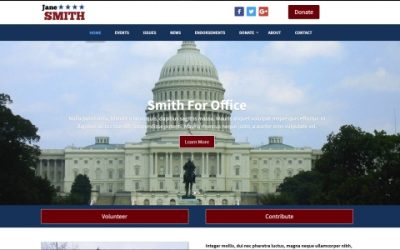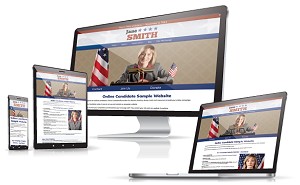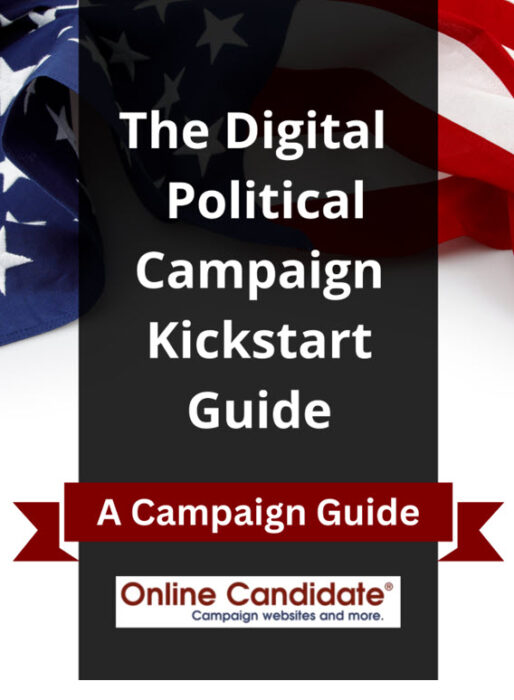Digital Marketing for Politicians – Strategies and Ideas
If you plan to perform digital online advertising this election season, be prepared for new changes in transparency and disclosure.
Digital advertising is growth industry. According to the Campaign Legal Center, $1.4 billion dollars were spent on digital ads in 2016, up from just $159.8 million in 2012. While political ads on television require a ‘paid for’ disclaimer, this rule does not currently apply to online ads.
Until now, web advertising in the political realm has been pretty much a free-for-all. That is starting to change as influence of online advertising grows. With recent problems, the face of political digital advertising may need a complete overhaul.
Facebook cracks down
Following the 3,000 Russia-linked political ads that appeared during the 2016 U.S. presidential election, Facebook worked to curb ad bots and trolls going forward.
Digital marketing transparency goes local
in the absence of Federal action, states and localities have made moves to increase advertising transparency. Both Seattle and Washington state’s campaign finance laws now require disclosure of those providing political ads and the amount of money paid for them.
What does this mean for local campaigns?
Other legislative requirements may be on the way. On a Federal level, the Honest Ads Act proposes that online advertising be regulated similarly to print, radio and television. This would require more transparency from Facebook, Twitter and Google about who is paying for political advertisements on their platforms.
Whether new laws pass or not, you can count on social media platforms requiring more information from political advertisers in 2018 and beyond.
Online Candidate provides an affordable, powerful way to build online presence. Find out why we are the choice for hundreds of campaign every election cycle.
Google Ads for Political Campaigns
Paid placement is the quickest way to put your local campaign website in the top positions of most major search engine searches — but only for the terms (keywords) that you are willing to “bid” for. The way PPC works is that you pay each time someone searches and then clicks through to your website using a search term that you bid on. For example, if you buy the keyword phrase “TinyTown Mayor,” your ad would display on the results page when somebody searches for “TinyTown Mayor.” If managed properly, pay per click can deliver very cost effective and targeted traffic.
By far, the largest PPC program is Google Ads (Formerly Google Adwords).
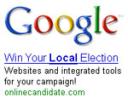 Google controls more than half of the web searches on any given day. The Google Ads program displays paid listings that appear above and to the right-hand side of its regular search results. Besides the Google search engine, advertisers also appear on affiliate sites.
Google controls more than half of the web searches on any given day. The Google Ads program displays paid listings that appear above and to the right-hand side of its regular search results. Besides the Google search engine, advertisers also appear on affiliate sites.
Google Ads is simple to set up and the most flexible of the major pay per click services. It has no monthly minimums, and your click-through costs are billed monthly to a credit card.
Running political ads? Your reach may be limited.
In recent years, Google has placed significant restrictions on how politicians and political campaigns can reach users. With restricted targeting for election ads, you can only use following criteria for targeting election ads:
- Geographic location (except radius around a location)
- Age, gender
- Contextual targeting options such as: ad placements, topics, keywords against sites, apps, pages and videos
Political content includes ads for political organizations, political parties, political issue advocacy or fundraising, and individual candidates and politicians.
Verification is required for all political or issue-based ads
Any individual or organization that purchases election advertising on Google or YouTube must provide information to Google confirming that they are a U.S. citizen or lawful permanent resident. Google also requires all political ads to display a ‘paid for’ disclosure. This verification process can take time, so you’ll want to start the process as early as possible.
Google Ad tips for your political campaign
- Limit your targeting as much as you can to the specific areas you want to reach.
- In the Edit Campaign Settings, keep the “show ads on Google and the content network” option unchecked. This will keep your ads only on the search engines.
- Use every term or phrase three times. Once as is, once surrounded by quotations – “John Jones” – and once surrounded by brackets – [John Jones]. Using quotations and brackets will give you the highest click through rates (CTR) and in turn, Google will give you higher placement for those terms.
- Use negative terms to keep away unwanted traffic. If you are running for Mayor of Tiny town, you might not want to pay for searches for “Tinytown school elections” if you are not running for school board. Consider putting the word “school” as a negative term in your ad group.
- For accurate ad comparisons between multiple ads, go to the Edit Campaign Settings and turn off “Automatically optimize ad serving for my ads”.
- The popularity of your ad will give you an advantage in ranking. Your ad can even rise above someone paying more for a specific keyword. Conversely, if your ad isn’t very successful, it may drop in the rankings, even though your cost per click remains the same.
- When you begin, set your maximum bid to minimum required, and set your daily budget to whatever Google recommends (assuming you can afford it, of course.). Note that if you set the daily budget limit lower than Google recommends, your ads may not be displayed on all searches.
- When you set a bid amount, Google will show you the expected average position of your ads. Your ad ranking (position) will vary depending on the click-through rate, but you will want to bid high enough to keep your ads within the top positions.
Finally, be sure to use negative keywords to keep your ad from showing for irrelevant searches.
Although there are restrictions, consider using Google Ads as a component to your political advertising mix.
For more political online strategies, check out Running for Office as an Online Candidate. The book that is packed with tips and strategies to develop and promote your political campaign website. Download a free sample [PDF].
Political WordPress Templates by Online Candidate
Online Candidate is pleased to announce WordPress Campaign Website Services. These services are designed for political candidates and organizations who want a WordPress-based website configured with the design, content and tools that campaign organizations require.
Custom Campaign WordPress Design Services
Done for you – a custom template design and full site content setup. Save valuable time as we design and set up your initial website content. After that, it’s all in your control. Addon options are also available to help you build your online presence faster.
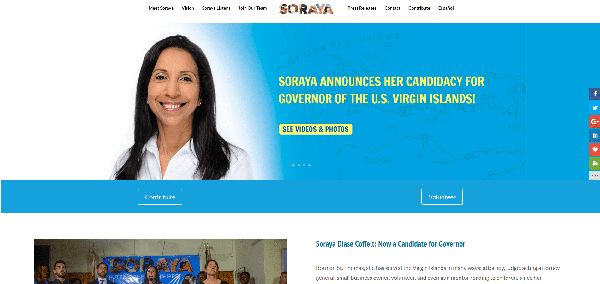
Our political WordPress design service includes:
- A Powerful Platform – Your site is powered by WordPress, the most popular content management system available.
- Save Time And Money – Get your site built faster and with less expense than with a traditional web developer.
- Built-In Tools – Campaign tools and features are included for a powerful online presence.
- Pre-Configured To Win – Your website comes configured with the pages, forms and plugins to give you a head start.
Learn more about our WordPress Campaign Websites.
Political WordPress Templates for Different Offices
Looking to build your own political WordPress campaign website? Save development time and money with our Divi Child Themes and templates. Clean design and fully responsive, these Divi child themes are designed for political campaigns and organizations. All content of the site demo is included. Little to no extra page development is needed. Swap out demo material and configure settings to your liking. [Template sales have been discontinued as of 2024.]
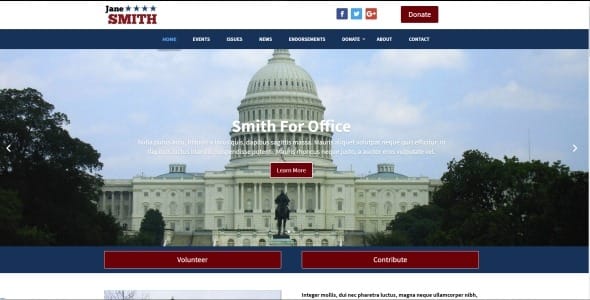




Learn more about our political WordPress templates and design services based on our Sheriff WordPress template, judicial template and School Board website template.
Questions about starting with WordPress? Contact us today!
Winning Tips For Your Local Political Campaign
Running for office can be arduous, exhausting and frustrating…if you don’t know how to run a local political campaign. And we know that running for office, particularly if it’s your first time, can be overwhelming. But, it doesn’t have to be. Below are important steps you can take to have an advantage over your opponent.
First, let’s talk metrics.
How many voters do you need to win an election? Almost every office has a minimum requirement of votes needed to win an election. That’s one number you would need. You can get that information from your electoral office. This voter file is of extreme importance, it tells you every registered voter and their party affiliation in your district.
The other number you would need is how many votes have been cast for the winner in previous elections so you have an idea of not just the minimum number of votes needed but how many votes it took to win in previous elections. You can find that information out at Ballotpedia.

Now, that you have this number you can create your game plan on how to reach out to your voters and engage with them. Where do you spend your time canvassing, calling and mailing to your voters? It’s not enough to just reach out to family and friends, though that is effective as a beginning campaign strategy. Activating voters in your district is essential to winning an election.
Tracking your potential voters is just as important as registering as a candidate. If you know who is or isn’t going to vote for you then you will know who to spend your time and money on to reach. It is also important to know what voters are either on the fence or don’t know about your candidacy. They become targets for persuasion as you approach Election Day.
Track your voters when they have been contacted. Follow-up is important so you can stay top of mind.
Contact points to track include:
- Call data – When you called, did you leave a message, did you speak with the voter?
- Email – When did you send an email, which email did you send, did it bounce back to you?
- Text – Did you send a text? Did the voter unsubscribe?
- Canvassing – Did you visit their home? Were you able to talk with them? What information did you leave behind?
- Follow-up – What is the next point of contact with your voter and what kind – voice, email, text, visit?
Starting Your Local Political Campaign The Right Way
Unless the candidate is extremely wealthy and well-known, local political candidates usually don’t have a lot of resources to start. On top of that, many candidates often lack name identification with voters. This can be a big problem if they are running against a popular opponent or an entrenched incumbent.
There are two things small campaigns should first focus on: Raising initial contributions and putting together a strong organization.
Initial donations often comes from the candidate’s friends and family. You can start with your family members, colleagues, friends and other supporters you know. Let your prospects know why you are running, why you think you can win – and how their support can make a difference.
Use this money to hold a a kick-off campaign fundraising event. Now you can broaden your reach to raise more money and to start spreading the word about your campaign. Try to make your event interesting and at a location that is affordable. You don’t want to spend the bulk of your donations just to hold more fundraisers!
Organize the structure of your campaign. At the very least, you will need a campaign manager, treasurer and volunteers.
Most candidates write out a political campaign plan before they run for office. Your plan will lay out your election strategies, and will depend several factors. These include the size of the electorate, the major local issues, and the timeline of the election season. To run a successful political campaign, you will need to tweak your plan throughout the election season.
[bctt tweet=”Most candidates write out their strategy before they start a run for elected office. And that strategy may change over the course of the election.” username=”onlinecandidate”]
Related Article: Running for Office – Frequently Asked Questions
Create Your Political Message
Now that you have a plan of action and your voter file, what is the message you are going to deliver?
You have to tell your own story…WHY are you running, what value will people voting for you get when you’re elected. Your message has to be clear and concise so it is easy for your constituents to understand quickly.
There are three primary points to hammer home to voters. Tell them about yourself, about your life and why you believe what you do. Voters don’t care about your resume. They want to relate to you on their own level – story points, family, hobbies, military service, etc.
Remember, it’s not about you and your achievements, it’s about what you can do for the voter. They want to know what is in it for them.
Spending Time and Money
You have your message and you know who your voters are and now it’s time to engage them. When you talk with your constituents, remember to ask them for their vote and see get their agreement. This way you will be able to record if they are or aren’t going to vote for you, and you’ll know your follow-up path.
Advertising Your Campaign Online
It goes without saying that having a presence on the web is instrumental. Most local campaigns start with a political website and a presence on social media. We are in the digital age now and need to be where are constituents are – and they are, for the most part, on social media.
![]()
Facebook, Twitter, Instagram and Linkedin are all relevant social sites. If you have to choose which sites to be on, choose Facebook and Instagram. Run ads to targeted audiences in your district and have a call to action to donate, learn more or click Like to show their support of your campaign.
Post about relevant issues you are addressing, your message and your story. Remember to drive home the value your constituents will receive if they vote for you. Make your message easy and simple to understand.
In order for your message to reach people online, you will need to budget for online advertising. Plan to devote a chunk of your budget toward online ads. This includes advertising on Facebook, where you can target people based on their demographics, interests and location. Google may be more restrictive, but you can still run pay per click and display ads to reach your desired audience. IP target advertising can allow you to reach voters at a household level. There are even less obvious methods like running banner ads on your local newspaper website.
With three weeks before the election you have plenty of time to make an impact on your voters. Put together a ‘get out the vote’ (GOTV) strategy and the steps you need to complete it. Canvass, call, email and text coupled with an informative website and active social campaigns will help reach as many voters as you can.
Becky Creighton is Director of Partnerships for Handraiser, a political campaign software that helps candidates track voters, provide communication channels between the candidate and voter and manages volunteers and canvassing efforts.
When Is The Best Time To Order Campaign Signage?
 Campaign yard signs are a valuable part of any election strategy. Even if you are not a fan of yard signs, they are a must-have if you are a political candidate. Your opponents will be using them, so you don’t want to be left out.
Campaign yard signs are a valuable part of any election strategy. Even if you are not a fan of yard signs, they are a must-have if you are a political candidate. Your opponents will be using them, so you don’t want to be left out.
There are different opinions as to to when is the best time to put up your signs. Generally, you should put up your campaign signs between four to eight weeks before the primary or general election. This allows for enough time to build name recognition with voters. If you put your signs up too early, they may lose impact as voters become ‘blind’ to them. If you put campaign signs up too late, they may not get the exposure you desire.
Of course, before you can display your signs, you need to order them.
Key Takeaways
- Start the ordering process for your campaign yard signs about two months before you need them.
- Professionals recommend that you put up campaign signs four to eight weeks ahead of a primary or general election.
- Plastic or Play-bag Signs are affordable, cheap and easy to ship. Corrugated plastic signs hold up well against the elements.
- Putting a ‘rush’ on a sign printing job will just add stress and cost to the project.
When is the best time to order yard signs?
Ideally, you should start the ordering process about two months before you need them. Having your yard signs ready to go early will help avoid a lot of logistical problems. Normal sign production is about 5 days and shipping time can be anywhere between 1 to 4 days. To be safe you should give yourself a minimum of at least two weeks. That way you will have enough time to put them out.
Order your campaign signage at least two months before you need it. Don’t wait until two weeks before Election Day to order.
Whatever you do, don’t put off ordering until the last minute. Putting a ‘rush’ on a printing job will just add stress and cost to the project. It may also lead to unintended errors. It’s better to get your signs designed and ordered early. Then you will have the signs ready to put out when you need them.
You may want to place a few orders throughout the season or as you can afford them. Start with some standard 18×24 inch yard signs. Most printers allow for batches as small as 50. As people request your signs, you’ll get an idea of how many more you need. As the campaign goes on, you may want to buy more and larger signs, like 4×8 foot road signs or billboards.
[bctt tweet=”Yard signs are part of your #political campaign’s branding. Make the most of them. http://ow.ly/wYTS30gBlRy”]

What type of yard signs should you order?
Candidates and organizations often struggle with the type of sign to purchase. There are basically three types of yard signs for political campaigns: plastic bag, corrugated plastic, and double-sided cardboard.
Here are the pros and cons each type of sign:
- Plastic or Play-bag Signs are affordable, cheap and easy to ship. They are basically plastic sleeves that can be slipped over U-shaped wires. The down side is that they tend to sag over time on their frames. And they do not work well as wall signs.
- Corrugated Plastic (poly coated) Signs holds up well against the elements and are easy to handle. They are most cost effective if a candidate runs often and is committed to the same message and look. They generally slide right over their metal frame. However, a light colored sign might not be entirely opaque. They tend to be a bit more expensive than other types of signs. They are also the most easily stolen.
- Double-Sided Cardboard Signs come in all shapes and sizes. They are double-sided and are stapled or glued to their frames. They easily double as wall signs. However, they don’t hold up as well in rough weather as plastic signs.
Your choice should be determined by your priorities such as price, quantity and re-usability.
Tips for designing effective political signs
Over time, a single campaign sign can be seen by hundreds or even thousands of people. Multiply that effect by the total number of yard signs promoting a campaign, and you have a powerful way to build candidate name recognition. Since all advertising is an extension of your brand, you’ll want your signs to look professional.
Here are some design tips to keep in mind:
- Consider creating a campaign logo early. Stick with a single logo. You may want to go with a block-style font, as script is harder to read. Use your campaign logo in your brochures and mailers to build a consistent ‘brand’.
- Generally, the candidate’s last name should be the largest element. The office running for should also be included, but can be somewhat smaller.
- Do not put too much information on the sign. They are generally read by motorists passing by. At best, you have only a few seconds to relay your message. Phrases ‘Re-Elect’ and ‘Vote For’ are basically redundant.
- Consider using at least two colors. This will increase the impact of the sign. Red, white and blue are traditional favorites. Other combos of color such as black and red or blue and yellow can work well, too.
- Don’t make your yard signs too small. A typical yard sign is 12” x 24”, but going for 18” x 24” or larger signs can produce more impact.
What is the visual impact?
You will only have a few seconds of a viewer’s attention, so the key to a good political sign content is for it to stand out. It should contain a short, memorable phrase with the candidate’s name and office like “Vote for Smith” or “Smith for Judge”.
Your signs should be readable and have high contrast of dark and light. Most political logos are readable in this way. Your sign design should match your other campaign materials such as your brochures and campaign website. Yard signs are part of your campaign’s branding, so it’s not a place to get overly creative.
When should you put up your campaign signs?
Many professionals recommend that you put up your campaign signs four to eight weeks ahead of the primaries or general election. If you display your campaign signs too early, they may lose their effectiveness and not have as much impact. If you put them up too late in the season, you will miss out on potential exposure and not have as much of an effect on your election chances.
You can coordinate putting out signs with your other advertising to help maximize voter impact.
When putting out your signage, follow the rules
Before you put up any yard signs, check your local election rules on where and when you can put out campaign signs. There may be restrictions on sizes, as well. You should also know when your signs must be taken down. (It’s usually within a week of Election Day.)
Check with your election board about sign placement near polling locations on Election Day. Some districts allow for signs, while others don’t. If your district allows signs, there will be specific regulations as to the size and distance from the polling place. You will also want to have enough signs available to place on Election Day.
Whether you are campaigning for mayor, sheriff, judge, school board member or even a state senator, a smart campaign sign strategy will boost your chances of victory.
How to dispose of old campaign signs
Once the election is over, the campaign signs remain. Here are ways to get rid of your old signage.
- Recycle your cardboard signs. Wire frames can be recycled or used for other purposes.
- Plastic signs can be painted and reused for other purposes.
- If your signs are not date-specific, they can saved for the next election.
- See more ideas on what to do with old political signs.
While we’re on the subject of recycling, be sure to recycle all of your campaign’s print material, except for the material that you might want to keep in a swipe file.
Related posts:
The Importance of Using Checklists in Campaigns
 Checklists are powerful tools in campaigns. Checklists turn completely green volunteers into competent workers. Checklists ensure quality and help staff manage themselves instead of using precious resources managing employees. The opportunities to use checklists in campaigns are nearly endless!
Checklists are powerful tools in campaigns. Checklists turn completely green volunteers into competent workers. Checklists ensure quality and help staff manage themselves instead of using precious resources managing employees. The opportunities to use checklists in campaigns are nearly endless!
Campaigns lend themselves to checklists because there is a series of logical steps towards the end of goal of victory. Smart candidates and staff can systematize these steps and develop checklists to keep the process moving. The difference between well run and poorly run campaign is the difference between a campaign that has a plan and a system and one that doesn’t.
The difference between a good campaign and a great campaign is the difference between how well the campaigns execute on their system.
Feel free to take this Field Event Checklist template and make it your own:
Location
_ Secure location one week before the date of the event or as soon as a date is decided by the candidate or a third party
_ Make sure an outside location has an alternative rain location
Crowd building
_ Determine the size of the room.
_ Make sure you are able to fill the room
_ Have an estimated hard count before hand
_ Call local officials at least two days before the event
Visuals
_ Signs
_ Banners
_ Stickers
_ Constituent group specific packets or handouts
_ Sign in sheet
_ Microphone
_ Podium
Price
_ Get budget approval of the final price five days prior to the event
_ Save invoices for all purchases
_ Events including food should not exceed $5.00 per person unless approved beforehand
Press
_ Press risers if necessary
_ Press advisory day before event
_ Take pictures
_ Email pictures to campaign press contact
_ Press release no later than 24 hours following the event
Follow up checklist
_ Follow up with phone calls and emails within two days of the event
_ Make copies of the sign in sheet
_ Enter sign in sheet data into database program
_ Send a copy of the sign in sheet to campaign contact to send out thank you notes
A staffer or a volunteer using a checklist like this one fill find it simple to organize a successful field event. Integrate checklists into your campaign like you have likely already integrated scripts for fundraising asks and scripts for the field. Scripts are to words as checklists are to processes. Winning campaigns rely on them just as much.
- Related: Checks To Make When Launching Your Campaign Website
- Political-Campaign-Checklist-For-Candidate [PDF]
For more checklists, tips, tricks and useful strategies, check out Running For Office as an Online Candidate. Our exclusive book provides a blueprint for candidates to use the web as part of an overall campaign strategy.



